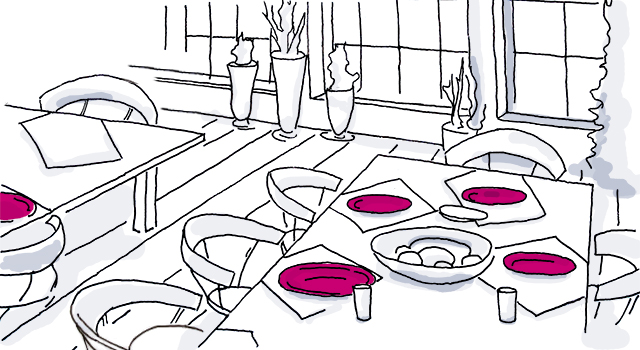
15 Helpful Catering Tips for Beginners
Demand for corporate and private catering has rapidly grown by 20% the past decade, collectively netting professionals in this industry $22 billion in 2019, which means this is set to be a promising field in years to come. Discover catering tips for beginners that will help you perfect your craft, avoid common mistakes, and wow event attendees below.
What do you need to know about catering?
The things you need to know about catering include how to create delicious menus, properly prep for events, and impress clients and guests. Keep reading to learn tips that specifically address these key catering areas.
Learn catering tips for beginners
The best catering tips for beginners offer insight into menu creation, event prep, and all those extra little details that leave a lasting impression on clients. Discover these actionable ideas you can use to excel at catering private and corporate events.
Craft amazing menus
Come up with delicious menus that delight guests, work within your client’s budget, and help you establish yourself in the catering world. Use these basic steps to avoid common catering mistakes and ace your first event.
1. Choose your service style.
Select one of the main catering service styles: buffet, tray pass, and plated.
Buffet catering service is made up of various self-serve stations. Choose this cost-effective option to save clients money on event staff and speed up food production by refilling large dishes all at once instead of making food to order.
Tray pass involves servers carrying food displays around the group. Select this budget-friendly meal alternative to add some variety to your catering menu and use fewer overall ingredients.
Plated catering refers to any sit-down meal that you serve to individuals at events such as weddings or charity fundraisers. Opt for this formal dining option for upscale get-togethers of any size or to foster community at smaller, more intimate events.
2. Pick a theme.
Select your theme based on the event type, your client’s goals, and the venue itself. Go with casual themes such as a BBQ or Luau for casual or private events during warmer months. Or, if you know the demographics of the event attendees, explore these interesting catering ideas for every generation. If you’re still not sure what theme to choose, start with one feature menu item and build the rest of your selection around that.
3. Use your signature dish.
Stand out from the crowd by using a signature dish or specialty cuisine in your catering menus whenever possible as this will become your calling card for future catering gigs. Since more than 50% of your future business will likely come through word of mouth, plan to receive calls for opportunities from past attendees who are dreaming of that one particular menu item you made.
4. Consider markup.
Keep in mind that your catering markup should be about three times the cost of the menu ingredients. Price this out ahead of time before you finalize the menu so there are no budget surprises for your client later on.
5. Save money.
Help service clients who are on a budget with some simple catering hacks. Opt for an entire menu of bite-sized foods over full meals to fill guests up without overspending. Consider meals such as soups or roasts that are easy to make in bulk to cut down on unnecessary ingredients.
Choose veggie-forward recipes whenever possible and don’t be afraid to haggle for fresh produce at local farmer’s markets. Or, slice meat thinly so guests can refill as needed and eliminate as much food waste as possible.
Order staples from bulk stores such as Costco or Sam’s Club and only price out the portion of the items you plan to use for this event, then keep the rest for your future gigs.
Prep like a pro
Practice proper food safety and save yourself some time with these practical catering prep suggestions every beginner should know.
6. Avoid cross-contamination.
Have separate cutting boards and utensils raw food, cooked food, and fresh produce. Thoroughly wash all cutting boards and utensils with hot, soapy water before and after you deal with any animal products. Also, change gloves when switching between these categories.
7. Sharpen knives.
Sharpen knives using this expert video tutorial to properly portion foods, speed up your prep process, and improve your food presentation. Purchase a Japanese whetstone (aka water stone or wet stone) from highly rated brands such as Kitayama or Sharp Pebble.
8. Monitor food temperature.
Keep an eye on your two primary cooking devices: your oven and your refrigerator. Cook meats and seafood at temperatures higher than 325 degrees Fahrenheit in the oven. Maintain 40 degrees or below inside your refrigerator at all times and measure it using both an interior and exterior thermometer.
9. Prioritize hygiene.
Always provide and use hand sanitizers and soaps plus industrial cleaning products for countertops. Wear kitchen prep gloves in the correct size and put on a hairnet if you have long hair or a beard. Use a freshly sanitized tasting spoon each time you test out an item. Wash hands before and after handling meat or seafood and take off any jewelry located on your fingers or wrists.
10. Make some dishes ahead of time.
Plan to spend the two days before your event shopping and one day before your event cleaning, cooking, and packing. Cut vegetables such as potatoes and carrots and store them in an airtight container. Prep any cold meals that don’t involve meat, seafood, eggs, or dressing so you can easily unseal and put the finishing touches on them at the event space. Freeze fresh-cut dough for crusts, cookies, and bread to save time on shaping and molding. And stick some chopped herbs in there too while you’re at it!

Impress clients and guests
Create memorable dining experiences for attendees with these lovely presentation details that will make your clients think you’re a seasoned professional.
11. Plate food beautifully.
Add unexpected pops of color on to otherwise plain dishes, such as rosemary sprigs in a bowl of mashed potatoes. Consider your color palette when you create your menu too – the more variety the better! Have plenty of spices, fresh herb sprigs, flowers, chopped nuts, and sprinkles on hand to decorate plates with. Layer plate items rather than place them side by side and drizzle sauces with a cleaned out spout bottle for a more professional effect.
12. Bring props and decor.
Have mini chalk or whiteboard food marker signs on hand along with some cardholders or thick decorative toothpicks. Make branded allergy cards with your logo on them that warn guests of common allergens and food concerns in certain dishes. Bring some seasonal decor pieces such as wreaths, pumpkins, and dried flowers along to spruce up blank spaces between tabled dishes. Order extra decorative fruits such as pomelos with the stems and leaves attached for practical snacking options plus a fresh pop of color on otherwise bland tablescapes.
13. Create strategic layouts.
Enter the exact dimensions of your serving area along with custom serving platter and furniture measurements to nail down your client’s vision for the flow and presentation of your catering. Create a few different layouts using a free event diagramming software such as Social Tables. Or, if your client already chose an event setup, get a feel for how you and your team will work in the kitchen by diagramming stations for prep, cooking, presentation, and clean up to save time with load in on the day.
14. Pack leftovers.
Treat your client and event hosts to some of their favorite leftovers. Ask them what the best items are throughout the night then surprise them with a couple of extra meals neatly packed (using the host’s own storage containers) and put away in their onsite fridge. Create a special dinner for two meal package if you cater a private event in someone’s home or batch prep a shelf-stable office snack for corporate clients to snack on the following week. Little perks like these add value to the experience of hiring you and make guests happy even after the event is all over.
15. Invest in beautiful serving tools.
Gorgeous serving spoons, forks, tongs, bowls, plates, and platters can elevate the look and feel of even the simplest dishes. Choose a quality set of gold or silver serving tools to bring with you as backup just in case the host or venue needs extra. Pack an extra couple large white serving bowls too while you’re at it. Use them to store extra ice and bottles at the bar, flip them over and use them platter stands to add height to a tablescape, or simply fill them with extra portions of food that is overflowing on the table.
Catering tips for beginners: FAQs
Explore the answers to these most frequently asked questions about catering tips for beginners to surpass the learning curve and become more successful faster.
The qualities of a good caterer include flexibility, staying calm under pressure, and creativity.
Prepare for a catering event by prepping your grocery shopping, food, and catering van or car ahead of time. Create a basic packing list that includes clean pots, pans, utensils, dish clothes, gloves, and safety products such as a first aid kit and gloves.
Wear a clean, pressed chef’s jacket and non-slip black shoes with any comfortable yet neat black pant or jean, depending on the formality of the event you are catering.
The three different types of caterers are front-facing caterers, catering chefs, and catering managers. Front-facing caterers often help with setup and guest relations, catering chefs stick to the kitchen, and catering managers oversee the entire catering team of servers and cooks.
Nail down the business side of catering tips for beginners
Now you know some of the best catering tips for beginners that include actionable information for everything from food prep to presentation to cleanliness. You also have all the answers to the most frequently asked related questions.
Continue to make your catering company an absolute success with our advice on starting a business. Then, learn more about how to find catering clients so you can start to apply these tips right away!

